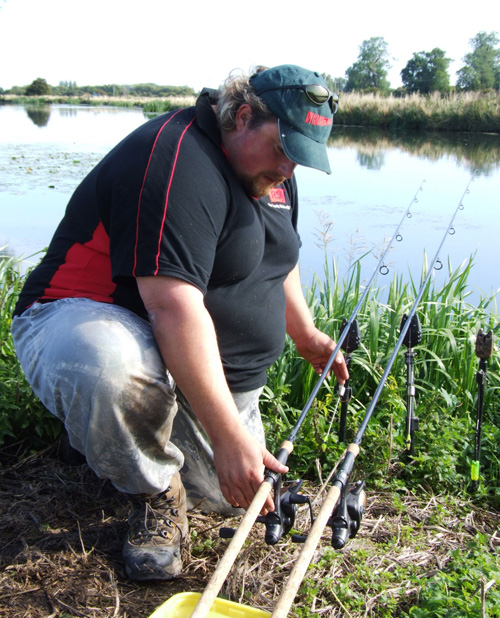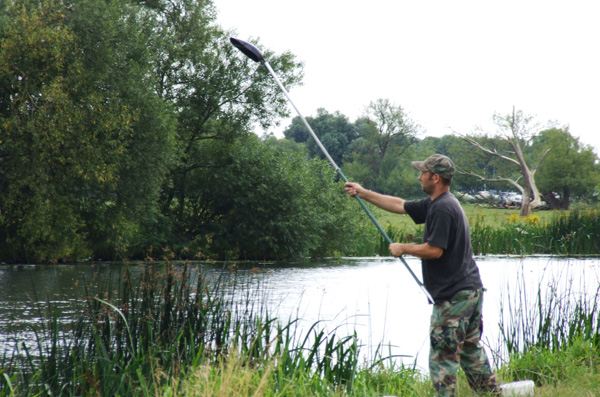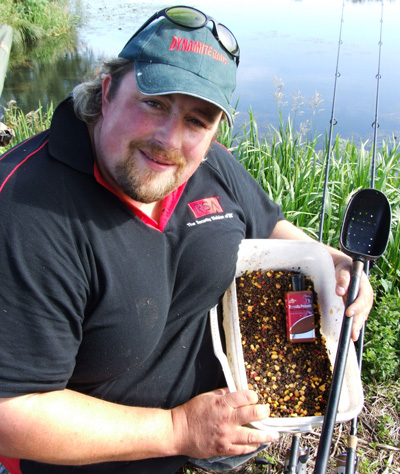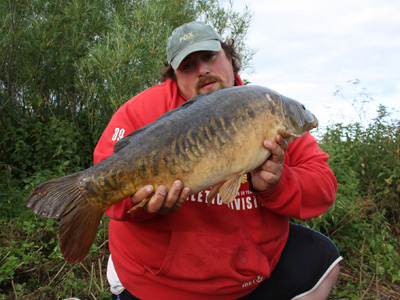So , presuming by now you haven’t actually been put off by the thought of a bit of river carping, let’s take a closer look at where to find a few fish and then examine the best way to set about trying to catch them.
So, where on a river is likely to hold carp?
 As with the distribution of all river species carp are not spread like the currants in a cake; they have their own favourite areas. Obvious features such as weed and lily beds will hold fish, but if your river is a moderate to slow-paced one then areas such as these are likely to be prolific. Better bets are areas where the carp can be close to the type of features that will offer them protection from the flow in times of flood.
As with the distribution of all river species carp are not spread like the currants in a cake; they have their own favourite areas. Obvious features such as weed and lily beds will hold fish, but if your river is a moderate to slow-paced one then areas such as these are likely to be prolific. Better bets are areas where the carp can be close to the type of features that will offer them protection from the flow in times of flood.
If you think about it every living creature will naturally try and set up home in an area where as many of their basic needs are met. Safety, food and water are the three main requisites for land animals, which is why so many of our villages and towns are situated close to rivers, which provide both food and water. Obviously a fish lives in water and food, in the natural environment anyway, should be pretty abundant, so their main priority is safety. The most catastrophic event in any moving water is a flood, so refuge in times of flood is extremely important.
To give you an example of this the biggest ever carp I have caught from a river came from the Old Bedford River (though it’s actually a man made drain) a few weeks after a summer flood. At this point in time there was a very high percentage of the drain’s carp population in a very small area, in this case the only bend in an otherwise dead straight drain and I was fortunate enough to find them.
Away from areas of refuge from floods other spots that are well worth a look are at river confluences, noticeably deeper or shallower areas, snaggy areas, marinas or boat turning basins, and cattle drinks.
Knowing and finding where the fish are is only half the battle though as by nature river carp are extremely nomadic and will roam miles of river without something to focus them into one area; this is where pre-baiting comes into the picture. With the frequent and judicious use of pre-bait those nomadic fish can be made to stay in one place for a length of time, but be warned it takes a bit of bait to do it!

My basic plan for pre-baiting revolves around baiting up every night for a week to ten days some two weeks before I want to start fishing, switching to every other day for the second week.
The amount of bait that you put in will, of course, depend upon your budget and to my mind the best way to pre-bait would probably be to do so with large boilies – and by large I’m talking 20mm plus. However there are few of us that can afford to do this, instead I use a few boilies but the bulk of my pre-bait is made up of particles – and cheap ones at that.
 My personal preference is for wheat mixed with a pigeon feed known as ‘Eco mix’ which contains wheat, maple peas, beans, maize and various small seeds. The great thing with this is that once it’s properly soaked in hot water for three or four days it swells up to nearly three times its size, which means that a little goes a long way. This is soaked along with the wheat in brewer’s buckets and any flavours or additives added to the water that they are soaked in so the particle takes it on nicely.
My personal preference is for wheat mixed with a pigeon feed known as ‘Eco mix’ which contains wheat, maple peas, beans, maize and various small seeds. The great thing with this is that once it’s properly soaked in hot water for three or four days it swells up to nearly three times its size, which means that a little goes a long way. This is soaked along with the wheat in brewer’s buckets and any flavours or additives added to the water that they are soaked in so the particle takes it on nicely.
For the baiting regime I detailed earlier I would use two bags of wheat and one of the Eco mix. With wheat currently retailing at about £7 for a 20 kilo sack and the Eco mix at £11 for the same, you can see that it’s not an expensive way of baiting up. There are, though, certain issues with introducing large amounts of particles into any river or drain and they come in the shape of a dustbin lid, weigh about 3-6lb on average and are covered in stinky slime.
Yep, you have guessed it; bream are the biggest drawback of them all. If you really want to know how many bream there are in a waterway this method of baiting will show you, believe me! Last opening day on the River Cam I had something like 13 bream in the hours of darkness but it could well have been a whole lot more. Because of the bream you really need to be careful about your choice of boilie and I certainly wouldn’t use anything smaller than 20mm on the hook, and they need to be of a firm to hard consistency too as soft baits get stripped off the hair very easily as was shown last opening night when I had the bumper haul from the Cam using a very soft bait that the bream had no problem destroying!
 Finally we need to look at how to introduce the pre-bait. Remember that we are looking at drawing in and holding nomadic fish so the most vital aspect is that the fish see the bait. On a big river I would start with a marginal spot and then run a line of bait diagonally across to the far margin. If there are two of us fishing I would do the same making an arrow across the water with the far margin having a liberal sprinkling too. Baiting in a pattern like this means the fish cannot help but see and find the bait if they are travelling past and by concentrating the bait on the near margin they can also be brought into a spot that can be comfortably fished and baited up via a baiting spoon on a long handle. Prior to this you may need to employ a spod or even bait boat to get the bait right across the river.
Finally we need to look at how to introduce the pre-bait. Remember that we are looking at drawing in and holding nomadic fish so the most vital aspect is that the fish see the bait. On a big river I would start with a marginal spot and then run a line of bait diagonally across to the far margin. If there are two of us fishing I would do the same making an arrow across the water with the far margin having a liberal sprinkling too. Baiting in a pattern like this means the fish cannot help but see and find the bait if they are travelling past and by concentrating the bait on the near margin they can also be brought into a spot that can be comfortably fished and baited up via a baiting spoon on a long handle. Prior to this you may need to employ a spod or even bait boat to get the bait right across the river.
A lot of what I have written in this article may seem like going to a lot of effort to catch a fish. If that’s your view then river carping may not be for you, unless you are prepared to try and stalk individual fish. However with just this little bit of effort you can reap the rewards in the shape of a carp that will probably have never seen a hook before.
In the final part of the series I will look at the fishing itself and the best gear to use for these hard fighting fish.













